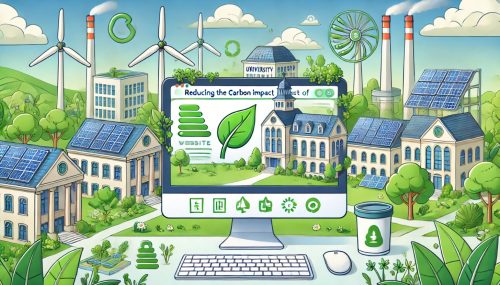The University of Dundee is committed to reducing all carbon emissions to a net zero position by 2045. That’s the best part of 20 years away depending on when you start counting. However, with the most difficult part of that road still to come, there’s no better time than the present to start doing something about it.
The University already has a number of plans in place to look at our Scope 1 and 2 emissions, but Scope 3 emissions are a whole other ball game. They’re the really difficult emissions that are so interwoven into our everyday lives, it’s a cultural change that’s required to address them.
When it comes to the University website and its wider web estate, we needed a plan to understand where we are and how to move forward.
Therein lies the problem! We really had no comprehension as to how much carbon any of our systems generated. Was it a lot, or a little? The digital industry is responsible for around 4% of global emissions, which is more than the aviation industry and since the Paris Agreement, the average web page size has increased by 64% on desktop and 132% on mobile.
The total University digital estate is a small percentage of that total. When it comes to the University web estate, it’s a small percentage of that again. However, if we’re to reach our target, every single person and system in the University is going to need to reduce, so onwards we go.
We had conducted our own rough calculations using tools like the Website Carbon Calculator. Firstly, it was taking an average page, getting the carbon impact and multiplying it by the yearly page views for the main University site. It was broad brush and ballpark at best. It was however the start of a journey that allowed us to begin to understand the complexities of calculating these things.
Trouble is that every page is different. We have lots of different content types that display things differently, so we refined it further to look at groups of similar pages, multiplied by an average figure for each content type, which further refined the final figure.
These tools are good, but they’re built on assumptions. How the electricity your server is using is generated. An average consumption figure for network usage and guestimates for end user devices.
With each refinement, the limitations became more apparent. Crucially, what became more elusive was understanding exactly what would reduce carbon emissions enough to make a difference.
Time to call in the professionals! We enlisted the help of Manifesto. A digital agency we had used in the past and who had responded to a query I’d put on LinkedIn for information. They were able to conduct an end-to-end mapping of everything that makes up www.dundee.ac.uk. They worked with our suppliers to look at realistic figures and produce a nicely formatted report at the end of it that gave us our answers.
1.8 tCO2e. That’s it. That’s the carbon impact of the University website. It’s a further refinement and we’re closer to understanding how to make an impact.
The truth that has struck me in all this is that my team and I can only impact a small percentage of that total. Even the most efficient website in the world, will still incur carbon at some point in its journey. So we’re going to need to be efficient internally in the information we generate. We’re going to need to push pressure on suppliers to use as much green energy as they can. We’re going to have to hope that users do their bit on their end and at some point, we’re going to need to do some carbon offsetting.
Big impacts start with little changes. The benefit we have is the University website is an intrinsic part of everyday life for a member of staff. So maybe, by affecting existing practices, and educating along the way, we can generate enough of a cultural movement to reach those stretching targets.
Ultimately it’s a collective effort that all starts with understanding the problem you’re trying to solve.
